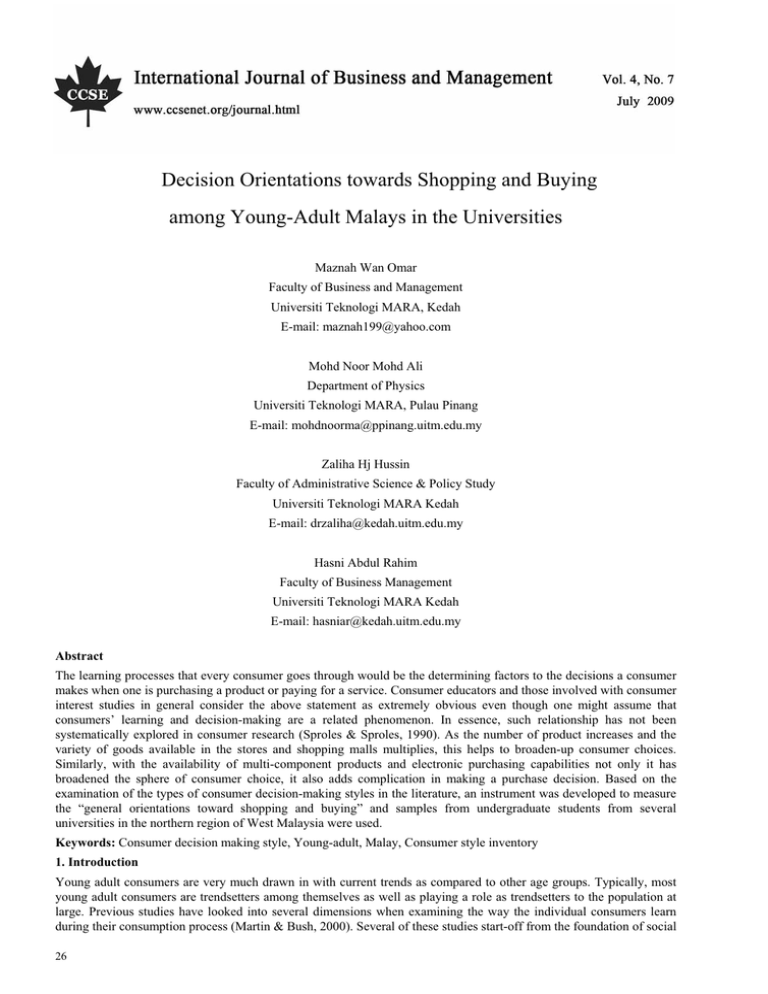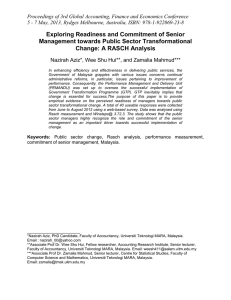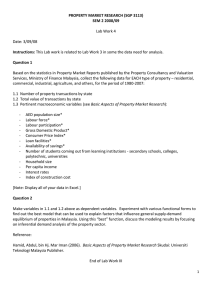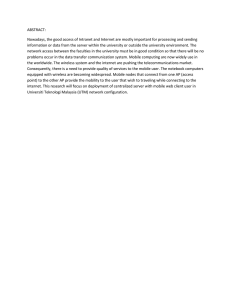
Vol. 4, No. 7
International Journal of Business and Management
Decision Orientations towards Shopping and Buying
among Young-Adult Malays in the Universities
Maznah Wan Omar
Faculty of Business and Management
Universiti Teknologi MARA, Kedah
E-mail: maznah199@yahoo.com
Mohd Noor Mohd Ali
Department of Physics
Universiti Teknologi MARA, Pulau Pinang
E-mail: mohdnoorma@ppinang.uitm.edu.my
Zaliha Hj Hussin
Faculty of Administrative Science & Policy Study
Universiti Teknologi MARA Kedah
E-mail: drzaliha@kedah.uitm.edu.my
Hasni Abdul Rahim
Faculty of Business Management
Universiti Teknologi MARA Kedah
E-mail: hasniar@kedah.uitm.edu.my
Abstract
The learning processes that every consumer goes through would be the determining factors to the decisions a consumer
makes when one is purchasing a product or paying for a service. Consumer educators and those involved with consumer
interest studies in general consider the above statement as extremely obvious even though one might assume that
consumers’ learning and decision-making are a related phenomenon. In essence, such relationship has not been
systematically explored in consumer research (Sproles & Sproles, 1990). As the number of product increases and the
variety of goods available in the stores and shopping malls multiplies, this helps to broaden-up consumer choices.
Similarly, with the availability of multi-component products and electronic purchasing capabilities not only it has
broadened the sphere of consumer choice, it also adds complication in making a purchase decision. Based on the
examination of the types of consumer decision-making styles in the literature, an instrument was developed to measure
the “general orientations toward shopping and buying” and samples from undergraduate students from several
universities in the northern region of West Malaysia were used.
Keywords: Consumer decision making style, Young-adult, Malay, Consumer style inventory
1. Introduction
Young adult consumers are very much drawn in with current trends as compared to other age groups. Typically, most
young adult consumers are trendsetters among themselves as well as playing a role as trendsetters to the population at
large. Previous studies have looked into several dimensions when examining the way the individual consumers learn
during their consumption process (Martin & Bush, 2000). Several of these studies start-off from the foundation of social
26
International Journal of Business and Management
July, 2009
learning theory, which proposes that a person learns common behaviors and attitudes from their previous experiences.
Sproles (1985) as well as Sproles and Kendall (1986) used data from samples of young consumers in the United States to
measure basic characteristics of consumer decision-making styles. They developed and validated a Consumer Styles
Inventory (CSI) for this purpose. In order to establish generality of CSI, Sproles and Kendall (1986) recommend that it
can be done by identifying and testing decision-making traits among different youth and adult groups. Socialization is a
process that usually takes place within the family and may shape consumption patterns. As such, it may affect not only the
present but also the future consumer well-being. The significance of young consumers is recognized when Ward (1974,
p.2) defines consumer socialization as “processes by which young people acquire skills, knowledge, and attitudes relevant
to their functioning as consumers in the marketplace.” Besides the process of socialization, the interrelationships between
specific consumer decision-making styles and individual learning styles as documented by Sproles and Sproles (1990) are
similarly important to consumer education.
2. Literature review
In general, consumer educators and those involved with consumer interest studies agree that the decisions made by a
consumer to purchase products or services are based on a certain process of learning. Even though one might assume that
consumers’ learning and decision-making are a related phenomenon, this relationship has not been systematically
explored in consumer research (Sproles & Sproles, 1990).
Learning style is defined as “the way each person absorbs and retains information’s and/or skills” (Sproles, 1990). Every
learner possesses an individual learning style, which is thought to be an enduring, patterned, and preferred mode of
learning. Evolving from early work on cognitive style, several major approaches to measure and characterize learning
styles have emerged (Fan et al., 1998). These range from approaches characterizing the cognitive aspects of learning, such
as abstractness or concreteness in learning, to those that consider students’ preferences for teaching methods (lectures,
labs, etc.) and environments (lighting, seating) (Fan et al., 1998). The central goal in understanding learning styles is to
explore how the mind operates during the process of learning.
A consumer decision-making style is defined as “mental orientation characterizing a consumer’s approach to making
consumer choices” (Sproles & Kendall, 1986). Relevant literatures suggest that consumer styles may be characterized by
the lifestyle approach, the consumer typology approach, and the consumer characteristics approach (Bettman, 1979,
Miller, 1981, Sproles, 1985). Based on these literatures, Sproles & Kendall (1986) reported the factor analytic validation
of a Consumer Styles Inventory measuring eight basic characteristics of Consumer Decision-Making Styles:1)
Perfectionist, High-Quality-Conscious Consumer - a characteristic measuring the degree to which a consumer searches
carefully and systematically for the best quality in products; 2) Brand-Conscious, Price-Equals-Quality Consumer - a
characteristic measuring a consumer’s orientation toward buying an expensive, well-known national brands; 3) Novelty
and Fashion-Conscious Consumer - a characteristics of identifying consumers who appear to prefer new and innovative
products and gain excitement from seeking out new things; 4) Recreational and Shopping-Conscious Consumer - a
characteristic measuring the extent to which a consumer finds shopping a pleasant activity and shops just for the fun of it;
5) Price-Conscious, Value-for-Money Consumer - a characteristic identifying a consumer with particularly high
consciousness of sale prices and lower prices in general; 6) Impulsive, Careless Consumer - a trait identifying consumers’
who have a tendency of buying at the spur of the moment and appear to be unconcerned about how much he or she spends
(or getting “best buys”); 7) Confused by Over Choice Consumer - a person perceiving too many brands and stores from
which to choose and who are likely to experience information overload in the market; and 8) Habitual, Brand-Loyal
Consumer - a characteristic indicating a consumer who repetitively chooses the same favorite brands and stores.
According to Hafstrom and Chung, (1992), decision making is more complex and even more important for consumers
today than in the past. Consumers today are besieged by advertising, news articles, and direct mailings that provide an
abundance of information, much of it with mixed messages. In addition, with an increase in the number and variety of
goods, stores, and shopping malls, and the availability of multi-component products and electronic purchasing
capabilities, thus broadened the sphere for consumer choice and have complicated decision making.
Sproles (1985) as well as Sproles and Kendall (1986) who developed and tested the Consumer Styles Inventory (CSI)
have helped to add a new direction in decision-making research. Characteristics of decision-making styles, used in the
CSI, can be useful in profiling an individual’s consumer style, in educating consumers, and in counseling families on
financial management (Sproles & Kendall, 1986). A consumer decision-making style is “a basic consumer personality,
analogous to the concept of personality in psychology” (Sproles & Kendall, 1986). They believe that measuring general
orientations of young consumers toward shopping and buying can identify decision-making styles.
27
Vol. 4, No. 7
International Journal of Business and Management
3. Method
3.1 Sampling Design
A sample of young-adult Malays from universities in Kedah, Pulau Pinang, and Perlis were used in the research reported
in this paper. Samples picked from the faculty of business studies classes were used to develop the method of
measurement young-adult decision making behaviors in this study.
To choose the sample for this study, probability random sampling was used. A probability sample is necessary if the
sample is to be representative of the population (Reeves, 1992). Therefore, samples were picked at random based on the
class list obtain from student affair department from the selected public Universities in the northern states of Peninsular
Malaysia.
3.2 Population and sample size
The unit of analysis for this study is individual students attending their first degree programmed in Universiti Sains
Malaysia, Universiti Teknologi MARA Perlis, Universiti Utara Malaysia and final year Diploma students from Universiti
Teknologi MARA Kedah, and Universiti Teknologi MARA Pulau Pinang who have had an independent buying
experience in purchasing goods without having any influence from their parents. The data used in this study were
collected in a four months period, from University Technology MARA in Kedah (100 samples), Perlis (93 samples), and
Pulau Pinang (106 samples), University Sains Malaysia, Pulau Pinang (101 samples), and University Utara Malaysia,
Sintok, Kedah (104 samples). A total of 504 respondents were chosen from the five universities mentioned above.
College students were chosen as our sample for the following reasons: researchers have an easy excess to respondents as
the researchers themselves are academic staff and it was not feasible to collect information from a representative sample
of Malay consumers. Furthermore students from these five universities come from all over the country; hence, the sample
is representative of young adult Malays in Malaysia (Fan et al., 1998).
To have a representative finding, the sampling technique used must be objective. This is an important effort adopted by
most researchers in order to furnish a finding pertinent to the general (Maznah Wan Omar, 2008). To choose the sample
for this study, a simple random sampling method was employed during the data collection procedure. The five universities
vary in size and specialization. University Sains Malaysia (USM) specializes in social sciences and basic sciences.
University Utara Malaysia (UUM) specializes in social sciences. University Technology MARA Pulau Pinang (UiTM
Pulau Pinang) specializes in Engineering. University Technology MARA Kedah (UiTM Kedah) specializes in industrial
arts and social science, and lastly University Technology MARA Perlis (UiTM Perlis) specializes in social sciences and
basic science.
3.3 Data Collection
For this study, a survey method was employed. Surveys are a better source of primary data collection in marketing and
social sciences in comparison to observation and experiments (Baker, 2001). Moreover, the survey method is put into use
because it does not entail control over behavioral actions and mainly focuses on current events (Mokhlis, 2006).
Questionnaires were randomly collected through a self-administered method with the help of the lecturers from all five
Universities in the Northern Region of West Malaysia. Self-administered questionnaire permits the interviewer to have an
opportunity to introduce the research topic and encourage the respondents to give their honest answers, administer
complex questionnaires and simplify difficult questions (Maznah Wan Omar, 2008). A total of 700 questionnaires were
distributed. However only 509 questionnaires were returned (73% return rate). In relation to that, only 504 questionnaires
were usable for this analysis. The rest of the questions had missing values for more than one items asked.
3.4 Method of Analyzing Data
Data analysis proceeded in two steps following the method used by Hafstrom and Chung (1992); Sproles (1985) and
Sproles and Kendall (1986). In the first step, factor analysis, the principle components method with Varimax rotation of
factors, was performed to identify characteristics of consumer decision-making. For comparability with Sproles and
Kendall’s work (1986), an eight-factor solution was used.
Factor analysis is designed to identify a set of variables in terms of a smaller number of hypothetical variables or to
explore underlying dimensions (Hair et al., 2006). Although it is desirable to have as many factors as possible in order to
capture the optimum number of consumer decision-making style variations, it also is necessary to have satisfactory
reliabilities for each factor to provide an adequate basis for generalizing to the population, assuming the sample is truly
representative. In the second step, Cronbach’s alpha, a conservative technique for assessing reliabilities for each factor
(Carmines & Zeller, 1979) was used. For consistency, it was decided that reliability should not be below .4, the same level
used by Hafstrom and Chung (1992) and Sproles and Kendall (1986).
28
International Journal of Business and Management
July, 2009
4. Discussions
Reliability coefficients were used to test on the consumer style characteristics among young adult Malay consumers in
UiTM Kedah. Only two style characteristics were below satisfactory level. The loading item was below .4. The Factor
that should be rejected is Factor 3 (.2776) for Recreational-shopping Conscious and Factor 7 (.3831) for Habitual, Brand
Loyal characteristic.
Respondents from UiTM Kedah were very conscious of the brand and price paid must equals to the Quality they received.
They were a Perfectionist as well as High-Quality Conscious Consumer.
The Reliability Coefficient tested on all 8 Factors for consumers in UiTM Pulau Pinang indicates that two consumer Style
Characteristics had a score below .4. The Factors are Factor 3 (.170), which stands for “Recreational-Shopping
Conscious” and Factor 8 (.371), which stands for “Price Value Conscious” characteristic.
The Factor analysis done on consumers in UiTM Pulau Pinang indicates that they were Brand and Price Equals Quality
Conscious consumer as well as “Confused by Over Choice”; nonetheless they were also a Habitual and Brand-Loyal
consumer.
The Reliability Coefficient done on consumer’s data from UiTM Perlis shows a score of above .4 for all Factors. Thus
Factor 1 to Factor 8 was all accepted.
Factor analysis done on the same consumers data from UiTM Perlis indicates that consumers in UiTM Perlis were Brand
and Price Equals Quality Conscious consumers, “Perfectionist” with “High-Quality conscious”; they were also a
“Recreational shopper” and at the same time were “Confused by Over Choice”. Nonetheless, they were concern about
time when doing purchase and were also careless and being impulsive when purchasing. They were Brand-Loyal and
Habitual consumers with high concern about the value of the price they pay for the product whenever they purchase a
product.
The reliability coefficient done on the data of consumers from University Sains Malaysia indicates that Young Adult
Malay from University Sains Malaysia (USM) were Brand and Price Equals Quality consumer. They were also a
Perfectionist and High-Quality conscious consumer. Unfortunately they were “Confused by Over Choice” but were
“Concerned about saving Time” when purchasing product. Nonetheless, they were Careless and Impulsive in buying.
Finally, the reliability analysis performed on 8 Consumer Style Characteristics for data on consumers from University
Utara Malaysia shows a reading that is above .4 for all Factors. Therefore all the Factors tested were accepted.
Factor analysis done on respondents’ data from University Utara Malaysia indicates that they were Brand Conscious and
Price Equals Quality Consumer. The respondents’ data indicates that Young Adult Malay from Universiti Utara Malaysia
was a Perfectionist and was Highly Conscious about Quality. At the same time they were Recreational Shopping
Conscious consumer and were confused by Over Choice. They were also Impulsive and Careless consumer with
additional characteristics of Brand loyal and they buy product on habitual basis.
5. Conclusion
Decision-making styles of young adult Malay consumers from Universiti Teknologi MARA Kedah, University Teknologi
MARA Perlis, University Teknologi MARA Pulau Pinang, University Sains Malaysia and Universiti Utara Malaysia
show that the similarities that exist among consumers from 5 different Universities were; they are Brand Conscious and
Price Equals Quality consumers.
Respondents who came from large universities like University Sains Malaysia, Universiti Teknologi MARA Perlis,
Universiti Teknologi MARA Pulau Pinang and University Utara Malaysia were all confused by too many choices of
product available to them. On the other hand, students whose university was situated far from big/large town like
University Utara Malaysia and UiTM Perlis indicates that they were Recreational-Shopping conscious consumers.
The implications obtained from the findings were that socialization and environment do shape the purchasing patterns of
consumers. Young consumers themselves formed an independent specialized market segment of its own for a variety of
goods because they made up a large group of people in a population.
Lastly, young people do play a great role in consumer decision making because they are at an age level, where they have
the capability and are economically able in making decision of their own in terms of what, how, when and where to buy.
References
Baker, M.J. (2001). Selecting a research methodology. The Marketing Review, 1(3), 373-397.
Bettman, J, Z. R. (1979). An Information Processing Theory of Consumer Choice. Reading, MA: Addison Wesley
Publishing Company.
Carmines, E. G. and Richard A. Z. (1979). Reliability and Validity Assessment. Beverly Hills, CA: Sage Publications.
29
International Journal of Business and Management
Vol. 4, No. 7
Fan, J. X. and Xio, J. J. (1998). Consumer Decision-Making Styles of Young Adult Chinese. The Journal of Consumer
affairs, 32(2), 276 -292.
Hafstrom, C., & Chung. (1992). Consumer Decision-Making Styles: Comparison between United States and Korean
Young Consumers. The Journal of Consumers Affairs, 26(1), 146-158.
Hair, J.F.Jr., Black, W.C., Babin, B.J., Anderson, R.E., & Tatham, R.L. (2006). Multivariate data analysis. 6th Edition,
Pearson International Edition, Pearson Prentice Hall.
Martin, C.A., & Bush, A.J. (2000). Do Role Models Influence Teenagers’ Purchase Intentions and Behavior? Journal of
Consumer Marketing, 17(5), 441-454.
Maznah Wan Omar. (2008). Understanding the mediating effect of customer satisfaction on the relationship of
salesperson behavior performance and customer loyalty, Unpublished Phd Thesis, Universiti Sains Malaysia, 86.
Miller, R. L. (1981). Economic Issues for Consumers. Third Edition, New York: West Publishing Company.
Mokhlis, S. (2006). The influence of religion on retail patronage behavior in Malaysia, Phd Thesis, Universiti of Sterling,
190-308.
Reeves, C.C. (1992). Quantitative research for the behavior sciences. New York, NY: John Wiley & Sons, Inc.
Sproles, George B. (1985). From Perfectionism to Faddism: Measuring Consumers’ Decision-Making Styles.
Proceedings. American Council on Consumer Interest: 79-85.
Sproles, G. B., & Kendall, E. L. (1986). A Methodology for Profiling Consumers’ Decision-Making Styles. The Journal
of Consumer Affairs, 20, 267-279.
Sproles, K. E., & Sproles., G, B. (1990). Consumer Decision-Making Styles as a Function of Individual Learning Styles.
The Journal of Consumer Affairs, 24, 134-147.
Ward, S. (1974). Consumer Socialization. Journal of Consumer Research, 1, 1-14.
Table 1. Reliability Coefficients for Eight Consumer Style Characteristics for young adult Malay Consumers from Five
Universities in the Northern Region of West Malaysia
Consumer Style Characteristics
Cronbach’s alpha subscale of
items loading above .4
Number of items used to compute
Cronbach’s alpha
Brand conscious (Factor 1)
.8345
11
Perfectionist (Factor 2)
.7735
7
Recreational-Shopping Conscious
(Factor 3)
.2776
6
Confused by Over choice (Factor
4)
.4831
5
Time-Energy Conserving (Factor
5)
.6020
3
Impulsive (Factor 6)
.5338
4
Habitual, Brand Loyal (7)
.3831
3
Price-Value Conscious (8)
.5362
3
From the above table, data shows that the reliability coefficients for factor 1, 2,4,5,6 and 8 were .48 and above, indicating
satisfactory levels of reliability. However, the alpha coefficients for factor 3 and factor 7 had lower reliabilities, indicating
that they may not be real factors in identifying decision-making styles of Young-Adult Malays from the five Universities
in the Northern Region of West Malaysia.
30





